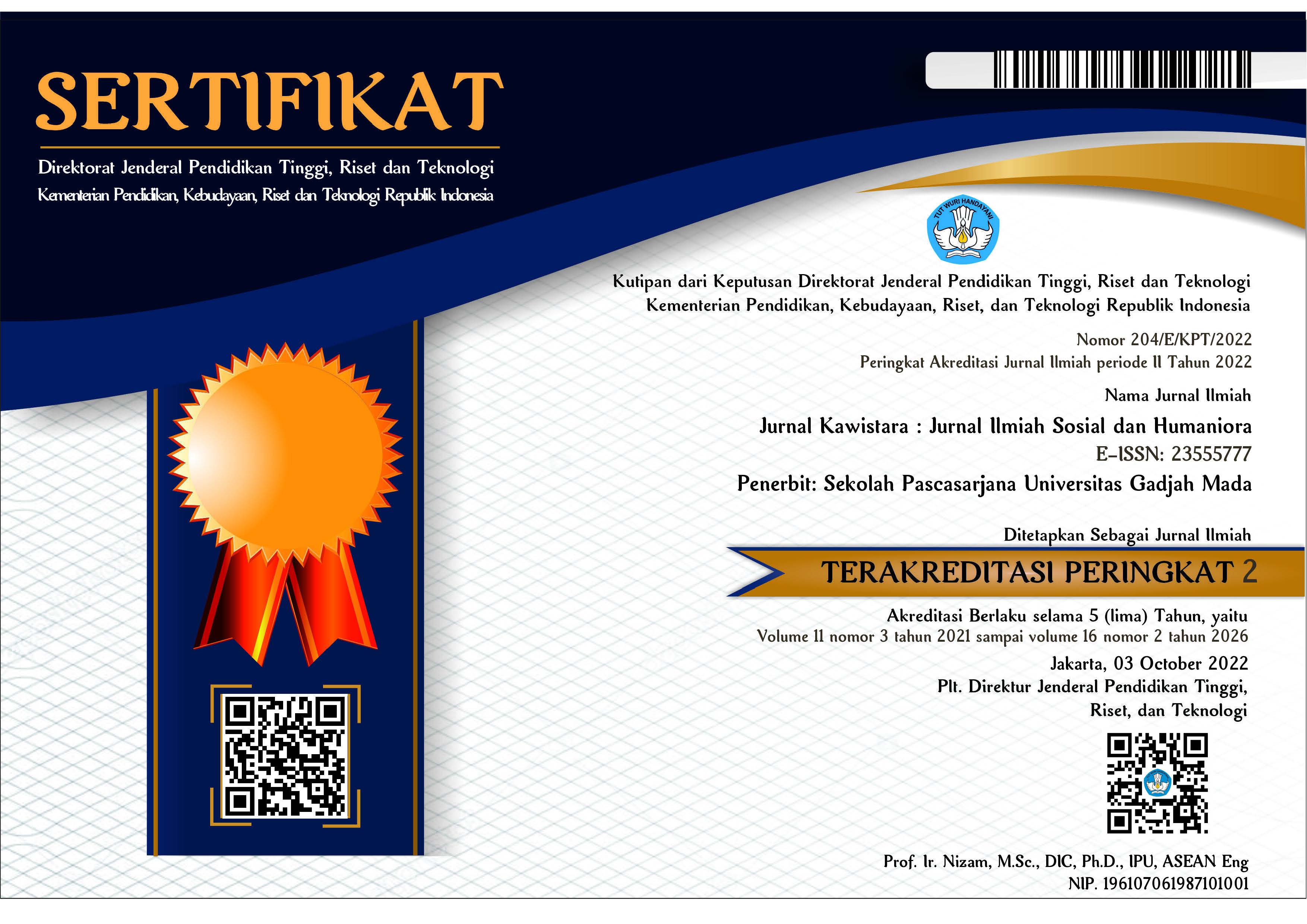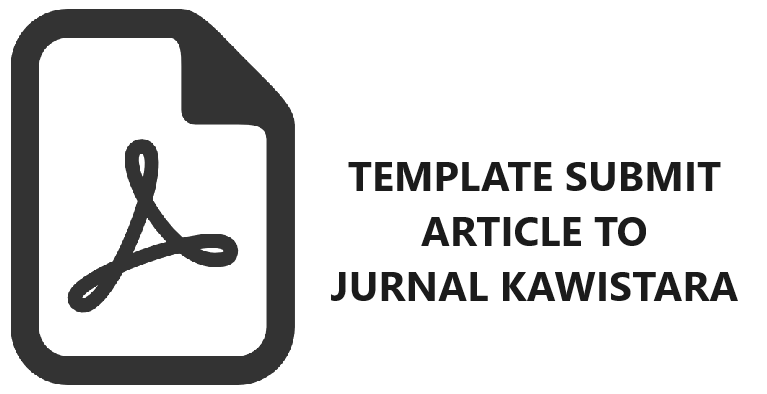Tourism Intention of People Susceptible to Covid-19 in The New Normal
Ikasari Kusuma Wardhani(1*), Hendrie Adji Kusworo(2), Dyah Widiyastuti(3)
(1) Ministry of Tourism and Creative Economy Universitas Gadjah Mada
(2) Universitas Gadjah Mada
(3) Universitas Gadjah Mada
(*) Corresponding Author
Abstract
COVID-19 pandemic has triggered a fundamental challenge to tourism, that is mobility. While research on tourism intention have been growing since the beginning of the pandemic, there was a lack of attention on discussion about people who face less opportunity for tourism due to their vulnerable physical conditions or people at-risk to COVID-19. Therefore, this research purported to reveal the influence of tourism constraints on tourism intention of people categorized as physically vulnerable to COVID-19 in the new normal era. Data collection was conducted through an online survey to citizens of Jakarta belonging to middle age and elderly group from end of June to September 2021. Multiple regression analysis with SPSS is used to test the relationship between tourism constraints and tourism intention, and analyze data of 337 respondents. The study showed that tourism intention of people at-risk from COVID-19 can be classified as high with intrapersonal constraints being the only significant constraints. This implies that the significant effect of intrapersonal constraints is not powerful enough to reduce the tourism intention of people susceptible to COVID-19.
Keywords
Full Text:
PDFReferences
Andreani, F.,&Njo,A. (2021). The impact of travel constraints on travel intention. Promoting Creative Tourism: Current Issues in Tourism Research, 625-658. https://doi.org/10.1201/9781003095484-94.
Aziz, N., Long, F. and Murad, S.M.A.(2021). Examining Travel Constraints and Perceived Risk on Intention to Travel during the COVID-19 Pandemic: The Case of Malaysian Consumers.
Statistics Indonesia. (2019). Statistik Wisatawan Nusantara 2019.
BBC News Online. (2020). (14 Mei 2020). Corona Virus May Never Go Away, World Health Organization Warns. Accessed 14 May 2020. https://www.bbc.com/news/world-52643682 pada tanggal 1 November 2020.
Cai, S. (2015). Leisure Patterns and Constraints Reposted by Selected Chinese University Students. Thesis, University of Waterloo.
CNN Indonesia Online. (2020). Ahli Ungkap Faktor Pasien Usia 45-65 Rentan Wafat Kena Corona.Available:https://www.cnnindonesia.com/teknologi/20200324160126-199-486545/ahli-ungkap-faktor-pasien-usia-45-65-rentan-wafat-kena-corona cited Now 2, 2020.
Darajat, M.N., and Kusworo, H.A. (2018). Pariwisata inklusif: Kebutuhan Fasilitasi Akses Wisatawan Difabel Tunadaksa Monoplegia dan Paraplegia di Pantai Boom, Banyuwangi – Jawa Timur. Dalam Eddyono,S. (Ed.), Pengembangan Masyarakat dalam Perspektif Pembangunan Sosial dan Kesejahteraan. hlm.183-200.CV. Buana Grafika.
Gao, J. and Kerstetter, D.L.(2016). Using an intersectionality perspective to uncover older Chinese female's perceived travel constraints and negotiation strategies. Tourism Management, 57, pp.128-138.
Gassiot Melian, A., Prats Planagumà, L. and Coromina Soler, L.(2018). Tourism constraints for Spanish tourists with disabilities: Scale development and validation. Document d'Analisi Geografica, 2018,vol.64, num.1,p.49-71.
Gössling, S., Scott, D. and Hall, C.M.(2020). Pandemics, tourism and global change: a rapid assessment of COVID-19. Journal of Sustainable Tourism, 29(1), pp.1-20. https://doi.org/10.1080/09669582.2020.1758708.
Jackson, E.L.(2000). Will research on leisure constraints still be relevant in the twenty-first century?. Journal of leisure Research, 32(1), pp.62-68.
Kazeminia, A., Del Chiappa, G. and Jafari, J.(2015). Seniors’ travel constraints and their coping strategies. Journal of travel research, 54(1), pp.80-93.
Khan, M.J., Chelliah, S., Khan, F. and Amin, S.(2019). Perceived risks, travel constraints and visit intention of young women travelers: the moderating role of travel motivation. Tourism Review.
Komisi Penanganan COVID-19 dan Pemulihan Ekonomi Nasional (KPCPEN).(2021). Peta Sebaran. Accessed 2 November 2021. https://covid19.go.id/peta-sebaran
Kompas TV Online. (2020). Dua Faktor Penyebab Jakarta Paling Banyak Kasus Pasien Positif Virus Corona. Accessed 20 October 2020 https://www.kompas.tv/article/71719/dua-faktor-penyebab-jakarta-paling-banyak-kasus-pasien-positif-virus-corona?page=all
Kono, S., Ito, E., Walker, G.J. and Gui, J.(2020). Predictive power of leisure constraint-negotiation models within the leisure-time physical activity context: A partial least squares structural equation modeling approach. Journal of Leisure Research, 51(3), pp.325-347.
Kyriazos, T.A.(2018). Applied psychometrics: sample size and sample power considerations in factor analysis (EFA, CFA) and SEM in general. Psychology, 9(08), p.2207.
Lee, B.K., Agarwal, S. and Kim, H.J.(2012). Influences of travel constraints on the people with disabilities’ intention to travel: An application of Seligman’s helplessness theory. Tourism Management, 33(3), pp.569-579.
Mas’udi, W. & Winata, P. (2020). New Normal: Perubahan Sosial Ekonomi dan Politik Akibat COVID-19. Yogyakarta: Gadjah Mada University Press.
Ministry of Health. (2016). Buku Kesehatan Lanjut Usia.
Newmeyer, T.S., (2003). Lead us through temptation: Thomas Cook, pastoral governance and the consumption of tourism.
Nguyen, N.M., Pham, M.Q. and Pham, M. (2021). Public's Travel Intention Following COVID-19 Pandemic Constrained: A Case Study in Vietnam. The Journal of Asian Finance, Economics and Business, 8(8), pp.181-189.
Özdemir, L.D.M.A. and Yildiz, L.D.S. (2020). How COVID-19 Outbreak Affects Tourists’s Travel Intentions? A Case Study in Turkey. Social Mentality and Researcher Thinkers Journal, 6(32), pp.1101-1113.
Park, S.H., Hsieh, C.M. and Lee, C.K. (2017). Examining Chinese college students’ intention to travel to Japan using the extended theory of planned behavior: Testing destination image and the mediating role of travel constraints. Journal of Travel & Tourism Marketing, 34(1), pp.113-131.
Priporas, C.V., Vassiliadis, C.A., Bellou, V. and Andronikidis, A.(2015). Exploring the constraint profile of winter sports resort tourist segments. Journal of travel research, 54(5), pp.659-671.
Pujihastuti, I.(2010). Prinsip penulisan kuesioner penelitian. CEFARS: Jurnal Agribisnis dan Pengembangan Wilayah, 2(1), pp.43-56.
Senbeto, D.L. and Hon, A.H., 2020. The impacts of social and economic crises on tourist behaviour and expenditure: an evolutionary approach. Current Issues in Tourism, 23(6), pp.740-755.
Sekaran, U. and Bougie, R.(2016). Research methods for business: A skill building approach. John Wiley & Sons.
Sugiyono. (2017). Metode Penelitian Kombinasi. Bandung: Alfabeta. Bandung.
Tan, W.K.(2020). Destination selection: Influence of tourists’ personality on perceived travel constraints. Journal of Vacation Marketing, 26(4), pp.442-456.
Urry, J.(1990). The Consumption of Tourism. Sociology, 24(1), pp.23-35.
Wachyuni, S.S. and Kusumaningrum, D.A.(2020). The effect of COVID-19 pandemic: How are the future tourist behavior? Journal of Education, Society and Behavioural Science, pp.67-76.
WHO. (2020). Older People and COVID-19. Accessed 31 October 2020. https://www.who.int/teams/social-determinants-of-health/covid-19.
Widiyastuti, D., Karakteristik dan Motivasi Berwisata Kelompok Lanjut Usia di KotaYogyakarta. Jurnal Nasional Pariwisata, 9(1), pp.82-90.
Wong, J.Y.,&Kuo. C.Y. (2021). How Chinese students' travel constraints influence their travel intentions in Thailand: Moderating role of cross-cultural adaptation. Sustainability, 13(4), 1-4. htpps://doi.org/10.3390/su13041665.
Article Metrics
Refbacks
- There are currently no refbacks.
Copyright (c) 2022 Ikasari Kusuma Wardhani; Hendrie Adji Kusworo; Dyah Widiyastuti

This work is licensed under a Creative Commons Attribution-ShareAlike 4.0 International License.
Jurnal Kawistara is published by the Graduate School, Universitas Gadjah Mada.











